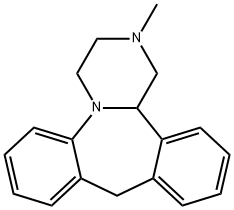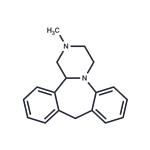Originator
Tolvin,Organon,W. Germany,1975
Uses
Serotonin receptor antagonist. Antidepressant
Definition
ChEBI: Mianserin is a dibenzoazepine (specifically 1,2,3,4,10,14b-hexahydrodibenzo[c,f]pyrazino[1,2-a]azepine) methyl-substituted on N-2. Closely related to (and now mostly superseded by) the tetracyclic antidepressant mirtazapinean, it is an atypical antidepressant used in the treatment of depression throughout Europe and elsewhere. It has a role as an antidepressant, a histamine agonist, a sedative, an alpha-adrenergic antagonist, an adrenergic uptake inhibitor, a serotonergic antagonist, a H1-receptor antagonist, an EC 3.4.21.26 (prolyl oligopeptidase) inhibitor and a geroprotector.
Manufacturing Process
(A) 25 g of 2-benzylaniline dissolved in 150 ml of benzene are cooled down in
an ice bath to 8°C. To this solution are added 15 ml of pyridine and after that
a solution of 15 ml of chloroacetyl chloride in 25 ml of benzene, maintaining
the temperature of the reaction mixture at 10° to 15°C. After stirring for 1
hour at room temperature 25 ml of water are added and the mixture is
shaken for 30 minutes. Next the mixture is sucked off and the benzene layer
separated. Then the benzene layer is washed successively with 2 N HCl, a
sodium carbonate solution and water. The extract dried on sodium sulfate is
evaporated and the residue crystallized together with the crystals obtained
already from benzene. Yield 18 g; MP 130° to 133°C.
(B) 40 g of N-chloroacetyl-2-benzylaniline are heated for 2 hours at 120°C
together with 50 ml of phosphorus oxychloride and 320 g of polyphosphoric
acid. Next the reaction mixture is poured on ice and extracted with benzene.
The extract is washed and dried on sodium sulfate and the benzene distilled
off. The product obtained (31g) yields after recrystallization 24 g of 6-
chloromethyl-morphanthridine of MP 136° to 137°C.
(C) 10 g of 6-chloromethyl-morphanthridine are passed into 150 ml of a
solution of methylamine in benzene (10%). After storage of the solution for
20 hours at 0° to 5°C the methylamine hydrochloride formed is sucked off
and the filtrate evaporated to dryness. There remains as residue 11 g of crude 6-methylaminomethyl-morphanthridine.
(D) 11 g of crude 6-methylaminomethyl-morphanthridine are dissolved in 50
ml of absolute ether. While cooling in ice 2.7 g of lithium aluminumhydride,
dissolved in 100 ml of absolute ether, are added. After boiling for 1 hour and
cooling down in ice 11 ml of water are added slowly dropwise while stirring.
After stirring for another 30 minutes at room temperature the mixture is
sucked off and the filtrate evaporated to obtain 11 g of crude 5,6-dihydro-6-
methylaminomethyl-morphanthridine in the form of a light yellow oil.
(E) 10 g of 5,6-dihydro-6-methylaminomethyl-morphanthridine are heated
slowly, in 30 minutes, from 100° to 160°C with 7 g of pure diethyloxalate and
after that from 160° to 180°C in 45 minutes. After cooling down the reaction
mixture is stirred with benzene. The crystals are sucked off and yield after
crystallization from dimethylformamide 9 g of 1,2-diketo-3(N)-methyl-
2,3,4,4a-tetrahydro-1H-pyrazino-[1,2-f]-morphanthridine of MP 245° to
247°C.
(F) 9 g of the diketo-pyrazino-morphanthridine compound obtained above are
reduced with diborane to give mianserin.
brand name
Athimil;Athymil;Bolvidon;Lantanon;Lerivon;Miansan;Norval;Org gb 94;Tolvin;Tolvon.
Therapeutic Function
Serotonin antagonist, Antihistaminic
World Health Organization (WHO)
Mianserin, a serotonin antagonist with antidepressant and
antihistaminic activity, was introduced in 1975 for the treatment of depressive
illness. Its use has since been associated with cases of severe blood dyscrasias,
particularly in elderly patients, including agranulocytosis, leucopenia and
granulocytopenia. Several drug regulatory authorities have reacted by stipulating
that blood counts should be monitored regularly during the first few months of
treatment and that administration should be discontinued immediately should any
signs possibly indicative of dyscrasia develop.
Synthesis Reference(s)
Journal of Medicinal Chemistry, 13, p. 35, 1970
DOI: 10.1021/jm00295a010




